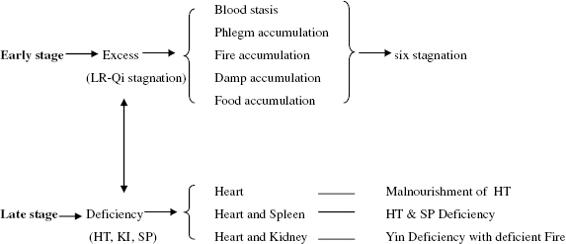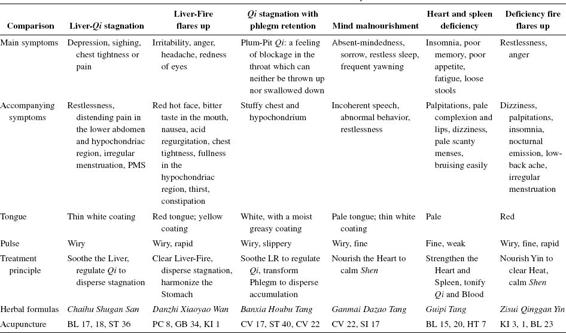The Introduction of Depression
Definition
There are narrow and broad meanings of “depression” in TCM. Broadly, depression indicates Qi, Blood, Phlegm, Fire, Food, or Damp stagnation caused by disharmony of the Zang-Fu organs. The narrow meaning refers to an abnormal emotional state and associated symptoms (e.g. moodiness, grief without reason, hypochondriac pain, Plum-Pit Syndrome) due to Qi stagnation. It is called Yu Zheng in TCM. “Yu” means “stagnation,” and “Zheng” means “syndrome” (Etiology and pathology of depression).
There is no depression diagnosis in TCM. It is classified into Yu Zheng, hypochondriac pain, Plum-Pit syndrome (Mei He Qi), crying and laughing without reason, moodiness (Zang Zao), Lily Disease (Bai He Bing), and Running Piglet syndrome (Ben Tun Qi).

Common manifestations
(1)Mild
- Mild feelings of depression while one is feeling uncomfortable.
- Brief feelings of irritability and self-doubt.
- Vagueness about where one is going in life or questioning whether one is really liked by others.
(2)Severe
- Feelings of worthlessness and hopelessness.
- Loss of interest in life.
- Recurring thoughts of death and suicide.
- Loss of appetite or increased appetite.
- Insomnia or sleeping too much.
- Irritability, and gloominess.
One or two mild symptoms for a brief period of time may be managed without professional help. The more symptoms of depression a person has or the more intense his/her symptoms, the greater the need for skilled mental health treatment.
The Explanation of Depression
Biological explanation
Depression has been identified as a disruption in the transmission of electrical charges from one cell to another in the brain. In simplified form, the fewer the neurotransmitters available for moving electrical charges from cell to cell, the greater the chance that a person will experience depressive symptoms.
Psychological explanation
A person’s thinking can affect his or her mood. In simple terms, when we think poorly or negatively about ourselves, other people, or the world, we are likely to have negative or depressive symptoms.
Social existential explanation
Environments, including work, are stressful and negatively reinforce depression. Identification of possible triggers and the practice of coping skills in these environments can be used to lessen depressive symptoms.
(1)Etiology and pathology (Etiology and pathology of depression)
Chief organs
- Liver (maintains free flow of Qi and regulates emotions; is also the “Sea of Blood”).
- Heart (houses the Mind).
Related organs
- Gall Bladder
- Spleen
- Stomach
- Lung
- Kidney
- Brain
- Uterus
Typical progression
Yu syndrome usually starts with Liver-Qi stagnation → Blood stasis → affects the five Zang together. Liver-Qi stagnation can lead to:
- Disharmony of collaterals → hypochondriac pain.
- The Liver overacting on the Spleen →
- Diarrhea, abdominal distension.
- Phlegm-Damp → throat → Plum-Pit Qi syndrome.
- The Liver overacting on the Stomach → nausea, vomiting.
- Fire → disturbs the Heart → Heart-Blood deficiency → Zang Zhao.
- Insulting the Lung → dispersing and descending function is hindered →
- Qi and Blood stagnation;
- Heart and Heart Yin deficiency → Bai He Bing.
- Affecting the Kidney (mother-and-son relation) → Yin/Essence deficiency → deficiency Fire.
- Disharmony between Chong Mai and Conception Vessel → PMS, irregular cycle or irregular length of menses.
The six stagnations interfere with each other
- Qi, Blood, Phlegm, Fire, Food, and Damp (the six stagnations) can interfere with each other and all can evolve into Fire over time.
- Qi stagnation usually occurs first, then Blood stasis.
- Qi stagnation affects the Spleen, leading to Phlegm and Dampness, which block Qi further.
- Damp blocks the Stomach and Spleen, leading to food retention.
Inter-transformation between excess and deficiency
The early stage is usually excess, presenting as Qi stagnation, Damp stagnation, Phlegm stagnation, Food stagnation, and Blood stagnation.
The chronic stage leads to deficiency, presenting as Qi deficiency, Blood deficiency, Heart and Spleen deficiency, or Heart-Yin and Kidney-Yin deficiency.
How to Diagnose and differentiate Depression(see Table 23)
Disease differentiation
(1)Jue syndrome vs. Yu syndrome
Jue syndrome:
- Sudden fainting and rough breathing.
- Mental confusion.
- Clenched hands.
- Locked jaw.
- Chest tightness after waking.
- Usually seen with hysteria.
Yu Syndrome:
- Usually with a depression history.
- Moodiness.
- Crying.
- Grief during attack.
- Triggered by emotions.
Key points for pattern differentiation
(2)Chief symptoms: Determine excess or deficiency
Excess:
- Discomfort everywhere.
- Combine with the tongue and pulse.
- Grief and crying without reason.
- Sighing.
- Plum-Pit Qi.
- Hypochondriac pain.
(3)Determine the Qi or blood level based on the disease history and manifestations
Early stage — Qi level:
- Wandering, distending pain triggered by emotions.

Basic points: PC 6, LR 3, SP 6.
Chronic stage — Blood level:
- Distending, fixed pain.
- Possibly amenorrhea.
- A purple tongue or purple spots on the tongue.
(4)Zang-Fu and the six stagnations
- Determine which Zang-Fu dominates.
- Determine which stagnation dominates and how many stagnations are involved.
Patterns
- Liver-Qi stagnation.
- Liver-Fire flaring up.
- Qi stagnation with Phlegm retention.
- Malnourishment of the Mind.
- Heart and Spleen deficiency.
- Deficiency Fire flaring up.
The Treatment of Depression
Principles
The basic treatment principles are:
- Soothe the Liver.
- Regulate Qi.
For excess:
- Transform Phlegm.
- Move Blood.
- Remove Damp.
- Promote digestion.
- Clear Fire.
For deficiency:
- Nourish the Heart and calm the Mind.
- Harmonize the Heart and Kidney.
- Tonify the Heart and Spleen.
Herbals
See Table 23.
Acupuncture
(1)Primary meridians
- Hand and Foot Jueyin (Pericardium and Liver).
- Foot Taiyin (Spleen).
(2)Primary points
- PC 6 (Calm the Mind and regulate Qi).
- LR 3 (soothe the Liver, regulate Qi, harmonize the Stomach, and strengthen the Spleen).
- SP 6 (strengthen the Spleen, transform Phlegm, and regulate Blood).
(3)Modification based on specific symptoms
- Loss of voice → GV 15, HT 5.
- Difficulty in swallowing → CV 22, 23.
- Insomnia → HT 7.
- Loss of vision → BL 1, GB 37.
- Paralysis (symptom of hysteria) → use powerful points in the area of paralysis, strong stimulation.
- Depressive state → LR 3, BL 18, ST 36, SP 6, PC 6, electrostimulation with low frequency on GV 20 and Yintang.
- Manic disorder state → CV 13, PC 5, 7.
Psychological counseling
- Provide encouragement and positive reinforcement.
- Shift the concentration to get the person out of negative trains of thought (the Five Elements Theory is a way to do this; invoke the emotion related to the element that corresponds to the controlling element for the emotional excess; for example, someone is overjoyful (HT), invoke fear (KI) to control the joy or use anger (LR) for overthinking (SP).
Mediation, Qigong, and Taiji
- Mediation and Qigong work directly with the Mind.
- Taiji is similar but more movement-based.
Auricular acupuncture
- Mediation and Qigong work directly with the Mind.
- Taiji is similar but more movement-based.
Auricular acupuncture
Heart, Subcortex, Forehead, Occipital, Shenmen, Brain, Liver, Spleen, Heart, Sympathetic.
Plum blossom needle
Light tapping on the neck and nape, GV and BL Meridians on the back area until there is local redness.
Moxibustion
Moxa on CV 12 for 15 min.

